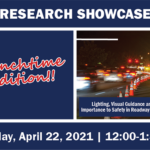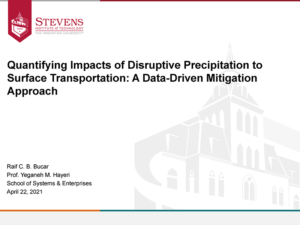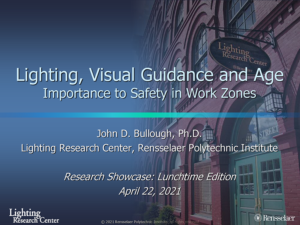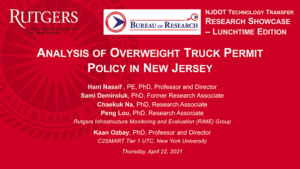On April 22, 2021, the NJDOT Bureau of Research hosted a Lunchtime Tech Talk! webinar, “Research Showcase: Lunchtime Edition!”. The event featured three important research studies that NJDOT was not able to include in the NJDOT Research Showcase virtual event held last October. The Showcase serves as an opportunity for the New Jersey transportation community to learn about the broad scope of academic research initiatives underway in New Jersey.
The three projects examined various issues in transportation from surface transportation vulnerability to climate change, to the impacts of lighting on work zone safety, to policies that regulate overweight trucks in New Jersey. After each presentation, webinar participants had an opportunity to pose questions of the presenter.
Quantifying Impacts of Disruptive Precipitation to Surface Transportation: A Data-Driven Mitigation Approach. Raif Bucar is a third-year Engineering Management Ph.D. student at Stevens Institute of Technology, currently conducting research on surface transportation vulnerability to flood events. The study adopts a multidisciplinary approach to look at the effects of not only 100 and 500 year floods, but also more frequent events that cause local flooding to assess the impact on mobility and accessibility in Hoboken, NJ. The resulting study explores flooding impacts on the transportation system in terms of mobility and accessibility metrics and can inform the flood mitigation measures and measures to improve resilience.
The study used a traffic simulation model to look at storm magnitude and high and low tide in relation to Vehicle Miles Traveled, Vehicle Hours Traveled, and Trips Completed. Mr. Bucar described analysis of data to predict flood risk and determine areas of higher probability of flooding by year-storm and tide to determine why some areas flood more often than others. The study explored urban characteristics including land cover and topography, elevation, slope, impervious coverage, and drainage system features, and looked at the correlation of these features with flooding.
Mr. Bucar described the application of this information to determine routing information for drivers by applying machine learning to develop a “most valuable path” that adjusts travel time based on each link in the route and diverts drivers in response to changing conditions during flood events. The study findings can also be applied to guide flood resilience transportation planning. Future work will look at other models to validate this study’s assumptions, and will investigate driver behavior during flood events and how drivers respond to new information.
Following the presentation, Mr. Bucar responded to questions asked through the chat feature:
Q. There is not as much research on rainfall-induced flooding. Why not?
A. There may be resistance to using interdisciplinary approaches to exploring this problem. This is an area that needs more research as the disruptive effects of flooding on transportation mobility is increasingly apparent.
Q. How translatable is this approach to other cities or locations?
A. Thus far, we have not applied the framework to other areas, but should be able to apply it to other controlled study areas. A study of larger areas, such as a state, will not show local differences. There is a limit to how much we can scale this model.
Q. How do you plan on factoring in driver behavior and driver knowledge of flood events in future studies?
A. We anticipate using surveys and controlled experiments.
Lighting, Visual Guidance and Age: Importance to Safety in Roadway Work Zones. Dr. John Bullough is the Director of Transportation and Safety Lighting Programs and a Course Instructor in the graduate program in lighting at the Lighting Research Center at Rensselaer Polytechnic Institute.
Work zones are complex visual environments, and particularly so at night when illumination is needed for workers to complete tasks and for drivers to see the work area and understand how to navigate around it. Roadway delineators, and steady and flashing lights used in work zones can cause glare and visual chaos that affect drivers’ ability to see well. These challenges are exacerbated for older drivers due to physical changes in the eye over time.
Dr. Bullough described the Relative Visual Performance (RVP) model used to look at the speed and accuracy of visual processing in relationship to light level, the contrast between an object and the background, the size of an object, and the age of the observer. The research compared the effects of: steady lighting; flashing lights at night and during the day; sign retroreflectivity, color, and lettering; and road delineators on younger and older drivers.
Dr. Bullough noted that, with an aging driving population, the needs of older drivers should be considered to improve road safety around work zones. Study conclusions emphasize that older drivers need higher light levels than younger adults, but warns that higher light levels can create more glare. There is a need for flashing warning light intensity specifications that reflect the needs of drivers of all ages. It was noted that higher reflectivity in sign sheeting can extend legibility distances and so assist older drivers. Dr. Bullough noted that monitoring of light levels is needed throughout their use to keep levels of glare low.
Several questions were posed to Dr. Bullough after his presentation:
Q. Was the information broken down for age groups over 60 years?
A. Optical changes continue to ages 70 and 80. However, there are other potential visual problems among individuals in these age groups – for example, cataracts, macular degeneration, and glaucoma which make generalizations more difficult.
Q. Does the color of light affect glare and visibility?
A. It depends on what we mean by “glare”. Red and blue lights – which we might find on police and flashing lights of highway maintenance trucks – have the same contrast-reducing characteristics regardless of color. However, people tend to be more sensitive to bluer colors; they find them much brighter, more glaring, more annoying and distracting even if they do not affect visibility any more than red or yellow lights of the same intensity. So, depending on what we mean by glare – if it’s that sensation of pain or annoyance – color matters a lot; if it is just visibility than it really comes down to candle-power, or candelas.
Q. What were the overall differences between urban and rural environments?
A. Urban environments tend to be more difficult for all drivers to find key information in the visual clutter. However, the effect is still much harder for older people than young people.
Q. How does eye recovery after glare differ between younger and older people?
A. Eyes in older people take twice as long to recover (3-4 seconds) after exposure to glare than in younger people.
Analysis of Overweight Truck Permit Policy in New Jersey. Dr. Hani Nassif is a professor at Rutgers, The State University of New Jersey, where he has established the Bridge Engineering Program. Dr. Nassif introduced the study and acknowledged the contribution of the research team that worked on this study and a prior study focused on the impact of freight on pavement and bridge infrastructure.
This research study explored whether New Jersey’s scheduled permit fees for overweight trucks allow NJDOT to recover all or part of the costs of the damage imposed by these vehicles traveling on NJ roads and bridges.
In a previous study, researchers had correlated truck overweight data with damage to bridges and pavements which showed higher rate of deterioration with higher rates of use by overweight trucks. The main question for this study considered whether the permit fees were sufficient to recover the costs incurred on the infrastructure. Then, in light of these findings, what policy recommendations could be made to change permit policies.
Dr. Nassif described various data sources and methods that were used to estimate the costs of damage to roads and bridges caused by overweight vehicles, including six years of data from the NJ Overweight Permit Database, Straight Line Diagrams of the NJ roadway network, GIS and the National Bridge Inventory including bridge location and conditions.
Dr. Nassif also provided an overview of NJ Overweight Permits, explaining the various types, validity, fee schedule and weight rules. He highlighted the challenges of effectively collecting fees for overweight trucks and use categories for which fees are not adequately collected. If a truck weighs more than 80,000 lbs., a permit should be obtained. Although, the State issues 100,000 permits each year, 96 percent of overweight trucks are estimated to be running without permits. These are not short hauls; the trip length is, on average, 50 miles.
The study also looked at fee permitting across the country. Each state uses one of three different permit fee structures: a flat fee; an oversize, overweight fee; and a new model which combines oversize, overweight, and mileage. The study included an effort to benchmark New Jersey against other states in terms of its fee structure. NJ is fourth highest in terms of overweight fee structure. Any revised policy must take into account these higher fees in relation to neighboring states.
Dr. Nassif noted that the study findings can inform discussion of alternative policies on trucking fees. The State can maintain the same fee schedule, add mileage to the fee calculation, or charge a flat fee. Dr. Nassif noted that it is not the objective of the state to recoup all the damage costs but perhaps to try to have all sectors of the economy pay their share in terms of the damage to the infrastructure. He suggested that, because trucks using more than six axles cause less damage, the use of more axles could be incentivized. Fees in NJ are already high, so an increase may not be feasible. All sectors of the trucking industry should pay their fair share. There may be greater efficiency and equity in imposing a permit fee structure that collects a greater fee for longer mileage trips.
Dr. Nassif answered several questions following his presentation:
Q. What would be your recommendation for regulating overweight trucks- to change to a flat fee or a mileage-based fee?
A. A combination of overweight and mileage fees might be most appropriate in NJ for a fair distribution of permit fees. This is similar to neighboring states. The average trip length is 50 miles for a permit. If a truck travels more, the State could add $1 for each additional mile would recoup 80 percent of the damage cost.
Q. Have you considered the cost of compliance in payment of fees for overweight vehicles?
We have been trying to work with the trucking association – we had a couple of workshops with stakeholders from agencies and trucking association – with the overall goal of enhancing the movement of goods. For example, the state could incentivize the use of a larger number of axles by lowering fees for these trucks. Truck weight enforcement is currently inefficient – it’s like chasing “cat and mouse”. Permits are not obtained for most overweight vehicles. Autonomous enforcement using accurate sensors along the road could result in citations and force drivers to get overweight permits. Weigh-in-Motion stations could be used as enforcement stations.
The enforcement needs to be more effective and we need more legislation; this legislation is under consideration in NY. NJ should consider this legislation to generate more revenue, and provide an equal footing for all parts of the trucking industry.
Q. With regional partners working together would we see more compliance?
A. There have been some regional efforts, including the Port Authority of New York and New Jersey calling for harmonizing the permitting process across state lines. New Jersey and New York could take the lead in advancing legislation to create a unified approach from Connecticut to Delaware and Maryland.
A recording of the webinar is available here.




